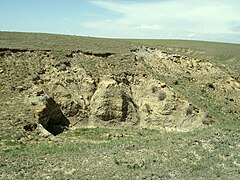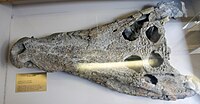Laramie Formation
| Laramie Formation | |
|---|---|
| Stratigraphic range: Upper Cretaceous | |
 | |
| Type | Geological formation |
| Underlies | Arapahoe Formation |
| Overlies | Fox Hills Formation |
| Thickness | 200-400 ft (60-120 m) |
| Lithology | |
| Primary | Sandstone, mudstone, clay, coal[1] |
| Location | |
| Region | |
| Country | |
| Type section | |
| Named by | Clarence King[2] |
The Laramie Formation is a geologic formation of Late Cretaceous (Maastrichtian) age, named by Clarence King in 1876 for exposures in northeastern Colorado, in the United States.[2] It was deposited on a coastal plain and in coastal swamps that flanked the Western Interior Seaway.[3] It contains coal, clay and uranium deposits, as well as plant and animal fossils, including dinosaur remains.[1]
Stratigraphy and Lithology
The Laramie Formation is exposed around the edges of the Denver Basin and ranges from 400–500 feet (120–150 m) on the western side of the basin, and 200–300 feet (60–90 m) thick on the eastern side. It rests conformably on the Fox Hills Sandstone and unconformably underlies the Arapahoe Conglomerate. The formation can be divided into an unnamed lower member containing bedded sandstone, clay and coal; and an unnamed upper member composed predominately of 90 to 190 m of drab-colored mudstone, some sandstone, and thin coal beds.[4][5] Nodular ironstone concretions occur in the mudstones that contain plant remains. Some of the material in the sandstones originated from silicic volcanoes far to the west.[6]
Resources
The coal and clay deposits of the Laramie Formation were once economically important.[5] Clay mining began in the Golden, Colorado area in 1877 and continued until the mid-twentieth century. Most of the clay was used to make bricks and tiles for building construction.[7]
It is estimated that about 130 million short tons of sub-bituminous coal were mined from the Laramie Formation between 1884 and 1979, mostly from seams in the lower part of the formation. Where the seams are relatively flat lying or gently dipping most of the mines were underground room and pillar operations, and where the seams are steeply inclined to vertical, stope mining was used. Relatively little surface mining was done.[3]
The Laramie Formation also hosts uranium deposits. The Leyden Coal Mine produced uranium for a few years as a byproduct of the coal mining. Uranium deposits also occur in sandstones of the Laramie Formation in Weld County, Colorado, and near the town of Grover, Colorado. (See Uranium mining in Colorado)
Paleofauna

Fossil vertebrates from the Laramie Formation were among the first dinosaurs to be discovered in the American West (Carpenter and Young 2003). In 1873, Edward D. Cope accompanied Ferdinand V. Hayden, who was leader of the U.S. Geological and Geographical Survey of the Territories. The route of the expedition included eastern Colorado where Cope collected specimens in what is now the Laramie Formation along Bijou Creek on the east side of the Denver Basin (Cope, 1874).[8]
Cope named three species of dinosaurs without description: Cinodon arctatus (later changed to Cionodon arctatus), Polyonax mortuarius and Agathaumas milo (later renamed Hadrosaurus occidentalis). These specimens are currently in the American Museum of Natural History. These specimens are very scrappy and the names no longer considered valid. Subsequent discoveries of dinosaurs occur through the formation, and include a nearly complete skull of Triceratops. Non-dinosaur vertebrates also occur (Carpenter 1979).[9]
List of Fossil Vertebrates (data from Carpenter 1979;[10] Hutchinson and Holroyd 2003)
Cartilaginous fishes
| Cartilaginous fishes of the Laramie Formation | ||||||
|---|---|---|---|---|---|---|
| Genus | Species | Location | Stratigraphic position | Abundance | Notes | |
|
cf. I. avonicola |
||||||
|
L. selachos |
||||||
|
M. bipartitus |
||||||
|
S. americana |
||||||
Bony fishes
| Bony fishes of the Laramie Formation | ||||||
|---|---|---|---|---|---|---|
| Genus | Species | Location | Stratigraphic position | Abundance | Notes | Images |
|
Indeterminate |
 | |||||
|
A. occidentalis |
||||||
Amphibians
| Amphibians of the Laramie Formation | ||||||
|---|---|---|---|---|---|---|
| Genus | Species | Location | Stratigraphic position | Abundance | Notes | Images |
|
Indeterminate |
 | |||||
|
L. bairdi |
||||||
|
O. kayi |
||||||
|
S. tectum |
||||||
Turtles
| Turtles of the Laramie Formation | ||||||
|---|---|---|---|---|---|---|
| Genus | Species | Location | Stratigraphic position | Abundance | Notes | |
|
Indeterminate |
||||||
|
cf. B. sinuosa |
||||||
|
C. victa |
||||||
|
cf. H. distincta |
||||||
|
cf. P. antique |
||||||
Squamates
| Squamates of the Laramie Formation | ||||||
|---|---|---|---|---|---|---|
| Genus | Species | Location | Stratigraphic position | Abundance | Notes | |
|
O. piger |
||||||
Crocodilians
| Crocodilians of the Laramie Formation | ||||||
|---|---|---|---|---|---|---|
| Genus | Species | Location | Stratigraphic position | Abundance | Notes | Images |
|
Indeterminate |
 | |||||
Dinosaurs
Color key
|
Notes Uncertain or tentative taxa are in small text; |
| Dinosaurs reported from the Laramie Formation | ||||||
|---|---|---|---|---|---|---|
| Genus | Species | Location | Stratigraphic position | Material | Notes | Images |
|
C. goldenensis |
  | |||||
|
Indeterminate |
||||||
|
cf. Edmontonia[11] |
Indeterminate[11] |
Nodosauridae (possibly Denversaurus) | ||||
|
E. annectens[11] |
||||||
|
O. minutus[11] |
"Partial metatarsals II-IV."[12] |
The specimens are now lost.[12] | ||||
|
Indeterminate[11] |
||||||
|
T. neglectus[11] |
||||||
|
T. latus[11] |
||||||
|
T. horridus[11] |
||||||
|
T. rex |
||||||
Mammals
| Mammals of the Laramie Formation | ||||||
|---|---|---|---|---|---|---|
| Genus | Species | Location | Stratigraphic position | Abundance | Notes | |
|
Indeterminate |
||||||
|
Indeterminate |
||||||
|
cf. Mesodma |
Indeterminate |
|||||
Paleoflora
Fossil pollen (palynomorphs) include bryophyte and pteridophyte spores, gymnosperm pollen, and abundant angiosperm pollen, including Aquilapollenites striatus, Ilexpollenites compactus, Interpollis cf. I. supplingensis, and Tricolpites interangulus.[13] The palynomorphs indicate an early Maastrichtian age (68-69 mya), which is supported by magnetostratigraphy.[14] Magnetostratigraphy also shows that the Laramie Formation becomes progressively younger eastward as deposition followed the regression of the Western Interior Seaway.
Fossil leaves are abundant, especially in the shales and sandstones associated with coal.[15] Dicot angiosperms dominate, with lesser amounts of ferns, palms, and herbaceous lycopods. Interestingly, conifers are rare. Common plants include “Ficus” planicostata, “Myrica” torreyi, Sabalites sp., Platanites marginata, and Marmarthia pearsonii.
Color key
|
Notes Uncertain or tentative taxa are in small text; |
| Flora of the Laramie Formation | ||||||
|---|---|---|---|---|---|---|
| Genus | Species | Location | Stratigraphic position | Abundance | Notes | Images |
|
Aquilapollenites striatus |
  | |||||
|
“Ficus” |
“Ficus” planicostata |
|||||
|
Ilexpollenites compactus |
||||||
|
Interpollis cf. I. supplingensis |
||||||
|
Marmarthia pearsonii |
||||||
|
“Myrica” |
“Myrica” torreyi |
|||||
|
Platanites marginata |
||||||
|
Sabalites sp. |
||||||
|
Tricolpites interangulus |
||||||
See also
Footnotes
- ^ a b U.S. Geological Survey. "Geologic Unit: Laramie". Retrieved 2014-12-27.
- ^ a b King, C. 1876. Report of the Geological Exploration of the Fortieth Parallel. U.S.Geographical and Geological Survey.
- ^ a b U.S. Geological Survey Professional Paper 1625-A, Chapter SD
- ^ Eldridge, G.H., 1888, On some stratigraphical and structural features of the country about Denver, Colorado: Colorado. Scientific Society Proceedings, v. 3, pt. 1, p. 86 118.
- ^ a b Shroba, R.R., and Carrara, P.E., 1996, Surficial geologic map of the Rocky Flats environmental technology site and vicinity, Jefferson and Boulder Counties, Colorado: U.S. Geological Survey Miscellaneous Investigations Series Map, I 2526.
- ^ Wilson, M. 2002. Petrographic provenance analysis of Kiowa Core sandstone samples, Denver Basin, Colorado. In K.R. Johnson, R.G. Raynolds and M.L. Reynolds (eds), Paleontology and Stratigraphy of Laramide Strata in the Denver Basin, Pt. I., Rocky Mountain Geology 37: 173-187.
- ^ Van Horn, R. 1957. Bedrock geology of the Golden Quadrangle, Colorado. U.S. Geological Survey, Map GQ-103.
- ^ Report on the vertebrate paleontology of northern Colorado. Geological Exploration of the Fortieth Parallel. U.S. Geological and Geographical Survey.
- ^ Vertebrate fauna of the Laramie Formation (Maastrichtian), Weld County, Colorado. Contributions to Geology, University of Wyoming 17: 37-49.
- ^ Carpenter, K. and Young, B. 2002. Late Cretaceous dinosaurs from the Denver Basin, Colorado. In K.R. Johnson, R.G. Raynolds and M.L. Reynolds (eds), Paleontology and Stratigraphy of Laramide Strata in the Denver Basin, Pt. I., Rocky Mountain Geology 37:237-254.
- ^ a b c d e f g h i j k l m n "3.4 Colorado, United States; 4. Laramie Formation," in Weishampel, et al. (2004). Page 581.
- ^ a b "Table 11.1," in Weishampel, et al. (2004). Page 216.
- ^ Nichols, D.J., and Fleming, R. F. 2002. Palynology and palynostratigraphy of Maastrichtian, Paleocene, and Eocene strata in the Denver Basin, Colorado. In K.R. Johnson, R.G. Raynolds and M.L. Reynolds (eds), Paleontology and Stratigraphy of Laramide Strata in the Denver Basin, Pt. I., Rocky Mountain Geology 37: 135-163.
- ^ *Hicks, J.F., Johnson, K.R., Obradovich, J. D., Miggins, D.P., and Tauxe, L. 2003. Magnetostratigraphyof Upper Cretaceous (Maastrichtian) to lower Eocene strata of the Denver Basin,Colorado. In K.R. Johnson, R.G. Raynolds and M.L. Reynolds (eds), Paleontology and Stratigraphy of Laramide Strata in the Denver Basin, Pt. II., Rocky Mountain Geology 38: 1-27.
- ^ Johnson, K. R., Reynolds, M.L., Werth, K.W., and Thomasson, J.R. 2003. Overview of theLate Cretaceous, early Paleocene, and early Eocene megafloras of the Denver Basin, Colorado. In K.R. Johnson, R.G. Raynolds and M.L. Reynolds (eds), Paleontology and Stratigraphy of Laramide Strata in the Denver Basin, Pt. II., Rocky Mountain Geology 38: 101-120.
References
- Weishampel, David B.; Dodson, Peter; and Osmólska, Halszka (eds.): The Dinosauria, 2nd, Berkeley: University of California Press. 861 pp. ISBN 0-520-24209-2.
